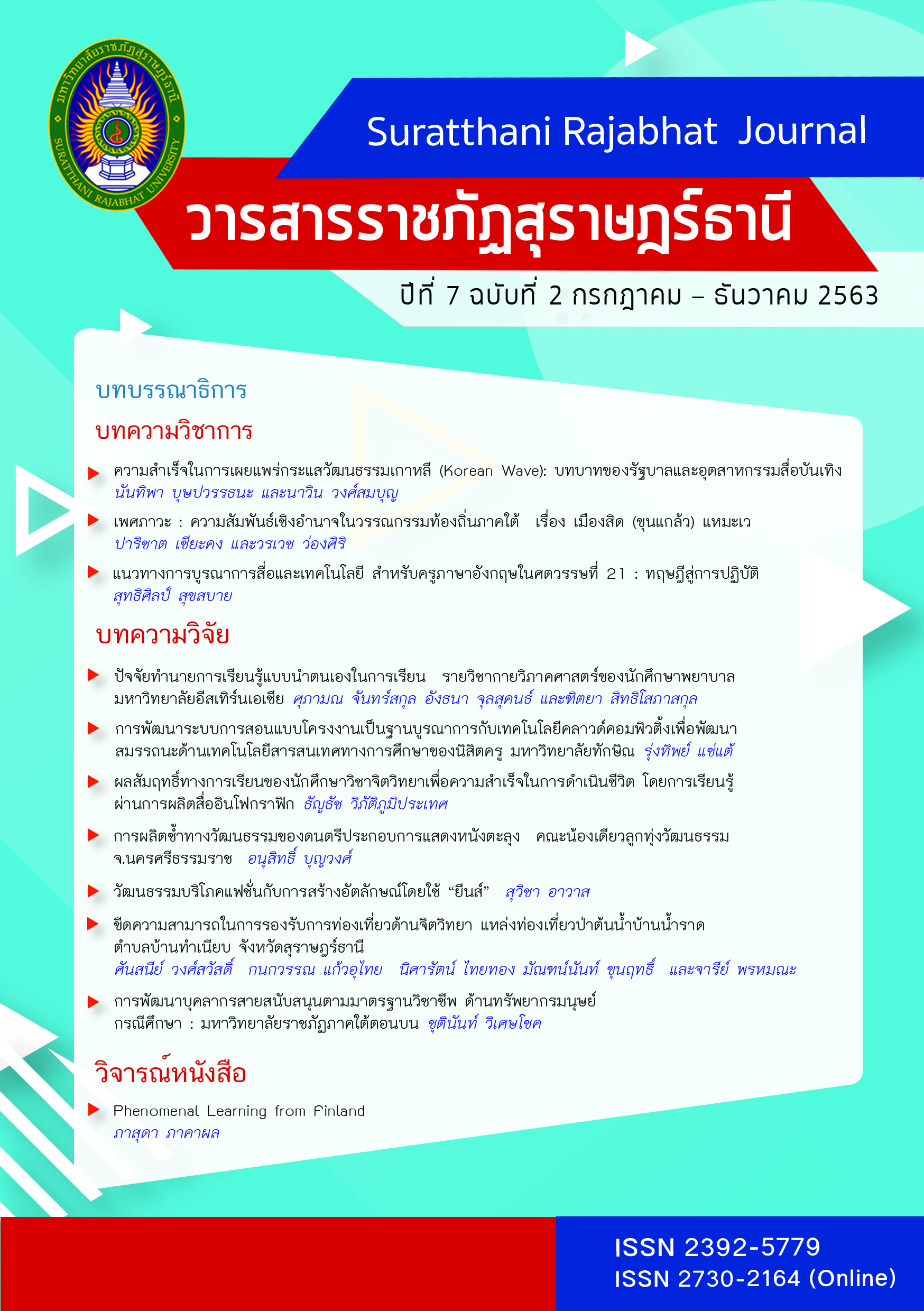Project-Based Instructional System Development Integreted with Cloud Computing Technology to Enhance Competency of Educational Information Technology for Student Teachers, Thanksin University
Main Article Content
Abstract
This research aimed 1) study the elements project-based teaching integrated with cloud computing technology to improve information technology competency of student teachers in Thaksin University; 2) create project-based teaching system integrated with cloud computing technology; 3) investigate results of implementing the project-based teaching integrated with cloud computing technology and ; 4) explore satisfaction of student teachers toward the project-based teaching integrated with cloud computing technology to improve information technology competency of student teachers in Thaksin University. The content for the research was from the Educational Information Technology course. The sample consisted of 30 3rd-year students from the Faculty of Education at Thaksin University selected by cluster random sampling.
The results were as :
1) The project-based instructional system integrated with cloud computing technology consisted of 9 elements (1) learning, teaching goals, (2) Instructor, (3) Learner, (4) teaching and learning strategies, (5) instructional media and learning sources, (6) learning environment, (7) learning and teaching activities, (8) the evaluation of learning outcomes, and (9) feedback.
2) The project-based instructional system integrated with cloud computing technology was divided into 3 main stages consisting of, 1) preparation 2) operation and 3) outcomes evaluation.
3) The results project-based instructional system integrated with cloud computing technology implementation that students’ competency on educational information increased the following : (1) Knowledge: students’ competency after learning higher than before learning at the statistical significance of .05, (2) Skills: the results showed the overall development statistically different at .05 and a pair mean comparison by Scheffe test for 4 skills found the post-test means were higher, (3) Individual characteristics showed the overall scores before and after the experiment were significantly different .05 level.
4) Students’ satisfaction towards developed instructional system overall was at the highest level.
5) The instructional system was certified by 7 experts at the most appropriate level.
Article Details
References
ทิศนา แขมมณี. (2553). ศาสตร์การสอน : องค์ความรู้เพื่อการจัดกระบวนการเรียนรู้ที่มีประสิทธิภาพ (พิมพ์ครั้งที่ 13). จุฬาลงกรณ์มหาวิทยาลัย.
นัทธีรัตน์ พีระพันธุ์. (2559). Studio TEACH กับการพัฒนานิสิตครูในศตวรรษที่ 21. วารสารพฤติกรรมศาสตร์มหาวิทยาลัยศรีนครินทรวิโรฒ, 22(1), 1-16.
ปารย์พิชชา ก้านจักร. (2558). รูปแบบการเรียนรู้แบบสืบเสาะผ่านคลาวด์เทคโนโลยีเพื่อส่งเสริมการคิดอย่างมีวิจารณญาณและความร่วมมือทางการเรียนรู้. [วิทยานิพนธ์ปริญญาดุษฎีบัณฑิต มหาวิทยาลัยเทคโนโลยีพระจอมเกล้าพระนครเหนือ].
พิมพันธ์ เดชะคุปต์และพเยาว์ ยินดีสุข. (2558). การจัดการเรียนรู้ในศตวรรษที่ 21.
โรงพิมพ์แห่งจุฬาลงกรณ์มหาวิทยาลัย.
มนตรี แย้มกสิกร. (2559). ชุมชนการเรียนรู้วิชาชีพ: ความท้าทายต่อการเปลี่ยนตนเองของครู. การประชุมวิชาการของคุรุสภา ประจำปี 2559 “การวิจัยนวัตกรรมการเรียนรู้และการจัดการศึกษาเพื่อการพัฒนาที่ยั่งยืน”.1-8.
เมธี คชาไพร. (2558). การพัฒนารูปแบบการเรียนการสอนแบบผสมผสานเพื่อเสริมสร้างความรู้และสมรรถนะด้านนวัตกรรมและเทคโนโลยีสารสนเทศทางการศึกษาสำหรับนิสิตหลักสูตรการศึกษาบัณฑิตมหาวิทยาลัยศรีนครินทรวิโรฒ. รายงานสืบเนื่องจากการประชุมสัมมนาวิชาการนำเสนองานวิจัยระดับชาติและนานาชาติ(Proceedings) เครือข่ายบัณฑิตศึกษา มหาวิทยาลัยราชภัฏภาคเหนือ ครั้งที่ 15.
วาฤทธิ์ กันแก้ว และ ณมน จีรังสุวรรณ. (2558). การออกแบบรูปแบบการเรียนรู้ร่วมกันผ่านเทคโนโลยีคลาวด์เพื่อส่งเสริมความคิดสร้างสรรค์ของนักศึกษาระดับอุดมศึกษา. วารสารวิชาการครุศาสตร์อุตสาหกรรมพระจอมเกล้าพระนครเหนือ, 6(1), 197-204.
วิจารณ์ พานิช. (2555). วิถีสร้างการเรียนรู้เพื่อศิษย์ ในศตวรรษที่ 21. มูลนิธิสดศรี-สฤษดิ์วงศ์.
ศิริพล แสนบุญส่ง, ธันว์รัชต์ สินธนะกุลและกฤช สินธนะกุล. (2561). การสังเคราะห์รูปแบบการเรียนการสอนแบบโครงงานเป็นฐานผ่านสิ่งแวดล้อมทางการเรียนรู้บนคลาวด์คอมพิวติง เพื่อส่งเสริมผลงานสร้างสรรค์และทักษะการทำงานร่วมกันเป็นทีมของนักศึกษาระดับปริญญาตรี. วารสารวิชาการมหาวิทยาลัยราชภัฏภูเก็ต, 14(2), 299-324.
ศิริพล แสนบุญส่ง. (2560). การพัฒนารูปแบบการจัดการเรียนรู้ห้องเรียนกลับด้านโดยใช้เทคโนโลยีคลาวด์ ที่มีผลต่อผลสัมฤทธิ์ทางการเรียนรายวิชาคอมพิวเตอร์สำหรับครูของนักศึกษาปริญญาตรี. วารสารบัณฑิตศึกษา มหาวิทยาลัยราชภัฏวไลยอลงกรณ์ ในพระบรมราชูปถัมภ์, 11(ฉบับพิเศษ), 133-146.
สำนักงานเลขาธิการสภาการศึกษา. (2555). การพัฒนาคุณลักษณะผู้เรียนยุคใหม่เพื่อรองรับการปฏิรูปการศึกษาในทศวรรษที่สองด้วยการบูรณาการไอซีทีในการจัดการเรียนรู้ด้วยโครงงาน. กรุงเทพฯ.
สำนักงานเลขาธิการสภาการศึกษา. (2556). บทวิเคราะห์สถานภาพการพัฒนาครูทั้งระบบและข้อเสนอแนะแนวทางการพัฒนาครูเพื่อคุณภาพผู้เรียน. http://www.onec.go.th/onec_ backoffice/uploads/Book/ 1206-file.pdf.
สุภารัตน์ จันทร์แม้น. (2556). ผลการเรียนอีเลิร์นนิงแบบโครงงานที่มีต่อผลสัมฤทธิ์ทางการเรียนและพฤติกรรมการทำงานร่วมกันของนักศึกษาระดับปริญญาตรี คณะศึกษาศาสตร์ มหาวิทยาลัยศิลปากร. [วิทยานิพนธ์ปริญญามหาบัณฑิต, มหาวิทยาลัยศิลปากร].
สุมาลี ชัยเจริญ. (2557). การออกแบบการสอน หลักการ ทฤษฎี สู่การปฏิบัติ .
คณะศึกษาศาสตร์ มหาวิทยาลัยขอนแก่น.
สุวิมล ตันมี. (2552). การพัฒนารูปแบบการพัฒนาทักษะการสืบค้นสารสนเทศทางอินเทอร์เน็ตสำหรับ ช่วงชั้นที่ 4. [วิทยานิพนธ์ปริญญามหาบัณฑิต มหาวิทยาลัยบูรพา].
อาณัติ รัตนถิรกุล. (2561). EaaS ระบบบริการการเรียนการสอนสำหรับผู้สอนยุคดิจิทัล Education as a Service for Instructional in the Digital Age. วารสารวิชาการสถาบันวิทยาการจัดการแห่งแปซิฟิค,.4(1). 308-320.
Denton, D.W. (2012). Enhancing instruction through constructivism, cooperative learning, and cloud computing. TechTrends, 56(4),
34-41.
Guzdial, M. (1998). Technological support for project-based learning. ASCD yearbook: Learning with technology, 14, 47-71.
Hattie, J., & Timperley, H (2007). The power of feedback. Review of Educational Research,77(1), 81-112.
Mell, Peter, and Timothy Grance. (2011). The NIST Definition of Cloud Computing. NIST Special Publication 800-145. http://nvlpubs. nist.gov/nistpubs/Legacy/SP/nistspecialpublication800-145.pdf.
Papert, Seymour. (1993).Mindstorms:Children, Computers, And Powerful Ideas (2nded). Harper Collins Publishers Inc.
Partnership for 21 st Century Skills. (2009). Framework for 21 st Century Learning.http://www.p21.org/storage/documents/P21_Framework_ Definitions.pdf.
Yifei Wang & Bingyao Jin. (2010). The Application of SaaS Model in Network Education-Take Google Apps for Example. 2nd international Conference on Education Technology and Computer (ICETC). https://ieeexplore-ieee-org.edatabases.lib.buu.ac.th/stamp/stamp. jsp?tp=& arnumber=5529703.


